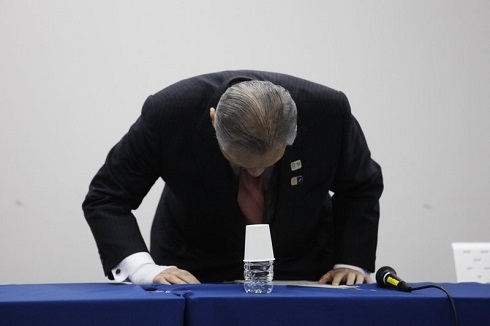Neil Simon, Broadway’s master of comedy, dies at 91
August 26, 2018
Miscellaneous

Simon died early Sunday of complications from pneumonia at New York Presbyterian Hospital in Manhattan, said Bill Evans, a longtime friend and spokesman for Shubert Organization theaters.
In the second half of the 20th century, Simon was the American theater’s most successful and prolific playwright, often chronicling middle class issues and fears. Starting with “Come Blow Your Horn” in 1961 and continuing into the next century, he rarely stopped working on a new play or musical. His list of credits is staggering.
The theater world quickly mourned his death, including Tony Award-winning actor and playwright Harvey Fierstein, who tweeted that Simon “could write a joke that would make you laugh, define the character, the situation, and even the world’s problems.”
Matthew Broderick, who in 1983 made his Broadway debut in Simon’s “Brighton Beach Memoirs” and his movie debut in Simon’s “Max Dugan Returns,” added: “I owe him a career. The theater has lost a brilliantly funny, unthinkably wonderful writer. And even after all this time, I feel I have lost a mentor, a father figure, a deep influence in my life and work.”
For seven months in 1967, he had four productions running at the same time on Broadway: “Barefoot in the Park,” ″The Odd Couple,” ″Sweet Charity,” and “The Star-Spangled Girl.”
Even before he launched his theater career, he made history as one of the famed stable of writers for comedian Sid Caesar that also included Woody Allen, Mel Brooks and Carl Reiner.
Simon was the recipient of four Tony Awards, the Pulitzer Prize, the Kennedy Center honors (1995), four Writers Guild of America Awards and an American Comedy Awards Lifetime Achievement honor. In 1983, he had a Broadway theater named after him when the Alvin was rechristened the Neil Simon Theatre.
In 2006, he won the Mark Twain Prize for American Humor, which honors work that draws from the American experience. The previous year had seen a popular revival of “The Odd Couple,” reuniting Nathan Lane and Matthew Broderick after their enormous success in “The Producers” several years earlier.
In a 1997 interview with The Washington Post, Simon reflected on his success: “I know that I have reached the pinnacle of rewards. There’s no more money anyone can pay me that I need. There are no awards they can give me that I haven’t won. I have no reason to write another play except that I am alive and I like to do it,” he said.
Simon had a rare stumble in the fall of 2009, when a Broadway revival of his “Brighton Beach Memoirs” closed abruptly after only nine performances because of poor ticket sales. It was to have run in repertory with Simon’s “Broadway Bound,” which was also canceled.
The bespectacled, mild-looking Simon (described in a New York Times magazine profile as looking like an accountant or librarian who dressed “just this side of drab”) was a relentless writer — and rewriter.
“I am most alive and most fulfilled sitting alone in a room, hoping that those words forming on the paper in the Smith-Corona will be the first perfect play ever written in a single draft,” Simon wrote in the introduction to one of the many anthologies of his plays.
He was a meticulous joke smith, peppering his plays, especially the early ones, with comic one-liners and humorous situations that critics said sometimes came at the expense of character and believability. No matter. For much of his career, audiences embraced his work, which often focused on middle-class, urban life, many of the plots drawn from his own personal experience.
“I don’t write social and political plays because I’ve always thought the family was the microcosm of what goes on in the world,” he told The Paris Review in 1992.
Simon received his first Tony Award in 1965 as best author — a category now discontinued — for “The Odd Couple,” although the comedy lost the best-play prize to Frank D. Gilroy’s “The Subject Was Roses.” He won a best-play Tony 20 years later for “Biloxi Blues.” In 1991, “Lost in Yonkers” received both the Tony and the Pulitzer Prize. And there was a special achievement Tony, too, in 1975.
Simon’s own life figured most prominently in what became known as his “Brighton Beach” trilogy — “Brighton Beach Memoirs,” ″Biloxi Blues” and “Broadway Bound” — which many consider his finest works. In them, Simon’s alter ego, Eugene Morris Jerome, makes his way from childhood to the U.S. Army to finally, on the verge of adulthood, a budding career as a writer.
Simon was born Marvin Neil Simon in New York and was raised in the Bronx and Washington Heights. He was a Depression-era child, his father, Irving, a garment-industry salesman. He was raised mostly by his strong-willed mother, Mamie, and mentored by his older brother, Danny, who nicknamed his younger sibling, Doc.
Simon attended New York University and the University of Colorado. After serving in the military in 1945 and 1946, he began writing with his brother for radio in 1948, and then for television, a period in their lives chronicled in Simon’s 1993 play, “Laughter on the 23rd Floor.”
The brothers wrote for such classic 1950s television series as “Your Show of Shows,” 90 minutes of live, original comedy starring Caesar and Imogene Coca, and later for “The Phil Silvers Show,” in which the popular comedian portrayed the conniving Army Sgt. Ernie Bilko.
Yet Simon grew dissatisfied with television writing and the network restrictions that accompanied it. Out of his frustration came “Come Blow Your Horn,” which starred Hal March and Warren Berlinger as two brothers (not unlike Danny and Neil Simon) trying to figure out what to do with their lives. The comedy ran for more than a year on Broadway. An audience member is said to have died on opening night.
But it was his second play, “Barefoot in the Park,” that really put Simon on the map. Critically well-received, the 1963 comedy, directed by Mike Nichols, concerned the tribulations of a pair of newlyweds played by Elizabeth Ashley and Robert Redford, who lived on the top floor of a New York brownstone.
Simon cemented that success two years later with “The Odd Couple,” a comedy about bickering roommates: Oscar, a gruff, slovenly sportswriter, and Felix, a neat, fussy photographer. Walter Matthau, as Oscar, and Art Carney, as Felix, starred on Broadway, with Matthau and Jack Lemmon playing the roles in a successful movie version. Jack Klugman and Tony Randall appeared in the TV series, which ran on ABC from 1970-1975. A female stage version was done on Broadway in 1985 with Rita Moreno as Olive (Oscar) and Sally Struthers as Florence (Felix). It was revived again as a TV series from 2015-17, starring Matthew Perry.
The play remains one of Simon’s most durable and popular works. Nathan Lane as Oscar and Matthew Broderick as Felix starred in a revival that was one of the biggest hits of the 2005-2006 Broadway season.
Besides “Sweet Charity” (1966), which starred Gwen Verdon as a goodhearted dance-hall hostess, and “Promises, Promises” (1968), based on Billy Wilder’s film “The Apartment,” Simon wrote the books for several other musicals.
“Little Me” (1962), adapted from Patrick Dennis’ best-selling spoof of show-biz autobiographies, featured a hardworking Sid Caesar in seven different roles. “They’re Playing Our Song” (1979), which had music by Marvin Hamlisch and lyrics by Carole Bayer Sager, ran for more than two years. But a musical version of Simon’s movie “The Goodbye Girl,” starring Martin Short and Bernadette Peters, had only a short run in 1993.
Many of his plays were turned into films as well. Besides “The Odd Couple,” he wrote the screenplays for movie versions of “Barefoot in the Park,” ″The Sunshine Boys,” ″The Prisoner of Second Avenue” and more.
Simon also wrote original screenplays, the best known being “The Goodbye Girl,” starring Richard Dreyfuss as a struggling actor, and “The Heartbreak Kid,” which featured Charles Grodin as a recently married man, lusting to drop his new wife for a blonde goddess played by Cybill Shepherd.
In his later years, Simon had more difficulty on Broadway. After the success of “Lost in Yonkers,” which starred Mercedes Ruehl as a gentle, simple-minded woman controlled by her domineering mother (Irene Worth), the playwright had a string of financially unsuccessful plays including “Jake’s Women,” ″Laughter on the 23rd Floor” and “Proposals.” Simon even went off-Broadway with “London Suite” in 1995 but it didn’t run long either.
“The Dinner Party,” a comedy set in Paris about husbands and ex-wives, was a modest hit in 2000, primarily because of the box-office strength of its two stars, Henry Winkler and John Ritter. A hit revival of “Promises, Promises” in 2010 starred Kristin Chenoweth and Sean Hayes.
Perhaps Simon’s most infamous production was the critically panned “Rose’s Dilemma,” which opened at off-Broadway’s nonprofit Manhattan Theatre Club in December 2003. Its star, Mary Tyler Moore, walked out of the show during preview performances after receiving a note from the playwright criticizing her performance. Moore was replaced by her understudy.
He wrote two memoirs, “Rewrites” (1996) and “The Play Goes On” (1999). They were combined into “Neil Simon’s Memoirs.”
Simon was married five times, twice to the same woman. His first wife, Joan Baim, died of cancer in 1973, after 20 years of marriage. They had two daughters, Ellen and Nancy, who survive him. Simon dealt with her death in “Chapter Two” (1977), telling the story of a widower who starts anew.
The playwright then married actress Marsha Mason, who had appeared in his stage comedy “The Good Doctor” and who went on to star in several films written by Simon including “The Goodbye Girl,” ″The Cheap Detective,” ″Chapter Two,” ″Only When I Laugh” and “Max Dugan Returns.” They divorced in 1982.
The playwright was married to his third wife, Diane Lander, twice — once in 1987-1988 and again in 1990-1998. Simon adopted Lander’s daughter, Bryn, from a previous marriage. Simon married his fourth wife, actress Elaine Joyce, in 1999. He also is survived by three grandchildren and one great-grandson.
“I suspect I shall keep on writing in a vain search for that perfect play. I hope I will keep my equilibrium and sense of humor when I’m told I haven’t achieved it,” Simon once said about his voluminous output of work. “At any rate, the trip has been wonderful. As George and Ira Gershwin said, ‘They Can’t Take That Away From Me.’”















